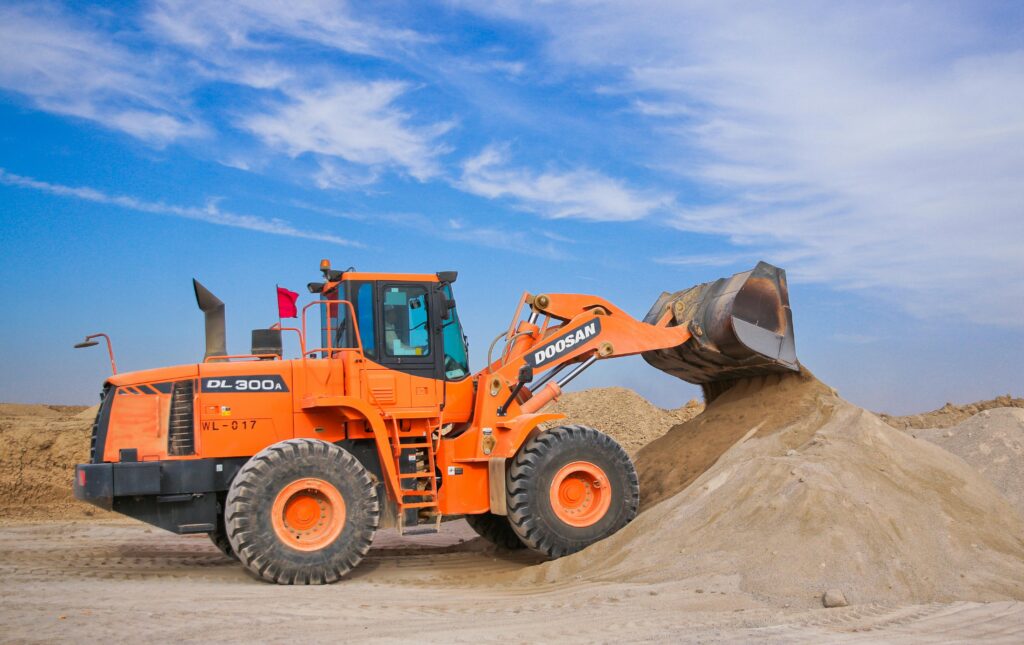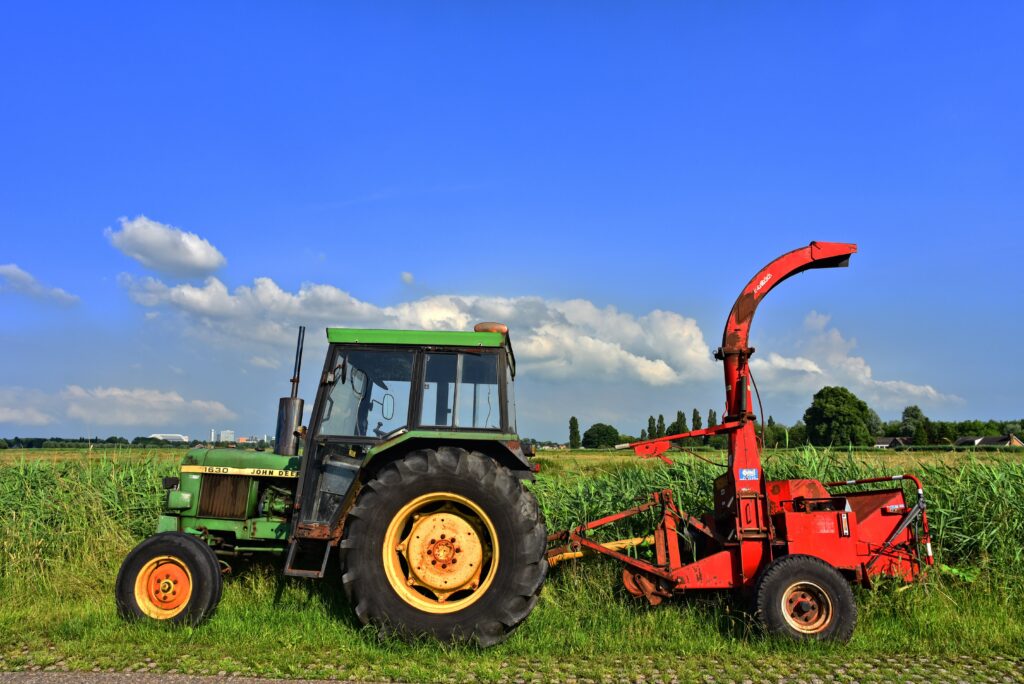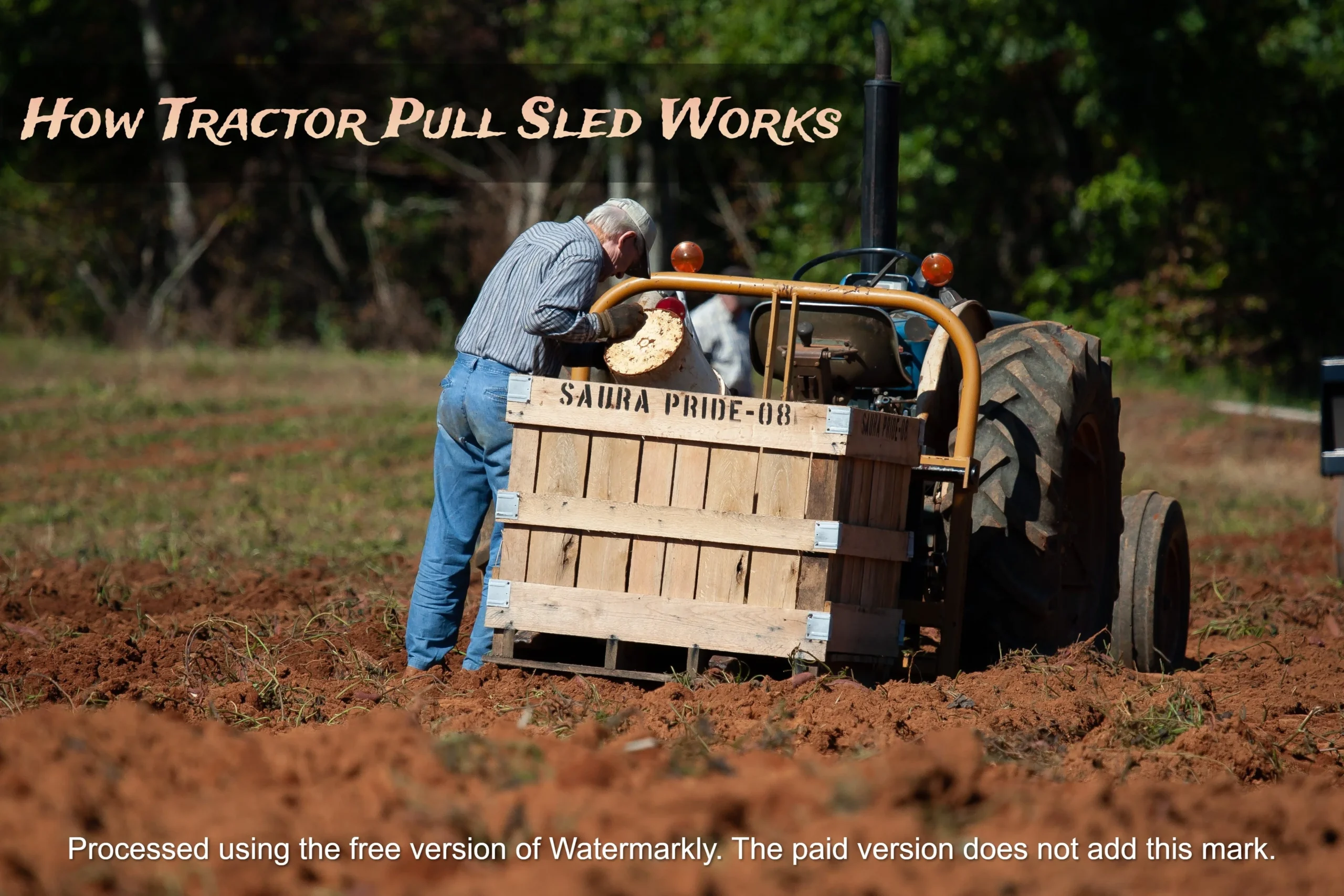Introduction
Tractor pulling is a motorsport where modified tractors or trucks compete to pull a weighted sled along a dirt track. The sled provides resistance that the tractor must overcome using sheer engine power. Tractor pulls test a machine’s brute force against the track, sled, and the clock.
The tractor pull sled is a key piece of equipment in this competition. Its design and weight play a major role in how difficult it is for tractors to pull it down the track. Understanding how a tractor pull sled works provides insight into this unique motorsport.

How a Tractor Pull Sled Functions
A tractor pull sled is essentially a large weighted platform on wheels that gets dragged down a track by tractors or trucks. Here are the key components that allow a sled to provide adjustable resistance:
Sled Frame and Wheels
The sled has a sturdy frame that holds all the components together. This frame sits on a set of wheels, usually with two in front and two behind. The wheels allow the sled to roll down the track as it gets pulled.
[Table with Sled Frame Materials]
| Material | Properties |
|---|---|
| Steel | Sturdy, durable, withstands force |
| Aluminum | Lightweight, resists corrosion |
The materials used for the sled frame and wheels must be strong enough to handle the immense stress of a pull. Steel is a common choice for its durability.
Weight Box
The main source of resistance comes from the weight box on the sled. This is a large container filled with heavy metal weights, typically scrap iron. By loading more weight into the box, the resistance increases.
The weight box is situated low on the frame, keeping the sled’s center of gravity low for stability. The box may have an angled front to help dig into the track surface for better traction. The total weight can be over 10,000 lbs on heavier sleds.
Pan and Skid Plates
Below the weight box is a replaceable pan that supports the weights. Skid plates are attached to the bottom of the pan to help it slide along the track. These plates are usually made of smooth, durable plastic like Ultra High Molecular Weight Polyethylene (UHMW).
The pan takes the brunt of the abrasive forces as the sled drags down the track. The skid plates prevent the steel pan from digging into the track and slowing the sled. The pan and plates can be easily replaced when worn out.
Adjustable Braking Systems
Sleds have braking systems that add even more resistance for tractors to overcome. The brakes are adjustable so operators can set just the right amount of braking force.
Some common braking systems include:
- Axle brakes: Brake pads or shoes squeeze the axles to create friction and slow the wheels
- Hitch brakes: Brakes built into the hitch that drag against the track
- Hydrostatic brakes: Use hydraulic pressure to apply brake pads/shoes
- Wheel brakes: Brakes mounted directly on the wheels
The harder the brakes are applied, the more the wheels resist rolling, making it tougher to pull the sled.

Sled Weights and Settings
The amount of weight on the sled largely determines how challenging the pull will be. More weight equals more resistance. Here are some key weights and settings:
[Table with Sled Weight Classes]
| Weight Class | Total Sled Weight |
|---|---|
| 5,500 lb Pro Stock | Up to 5,500 lbs |
| 10,000 lb Light Super Stock | 5,500 – 10,000 lbs |
| 30,000 lb Heavy Super Stock | 10,000 – 30,000 lbs |
Tractors and trucks compete in different weight classes based on their size and power. The sled is set up to match the class.
Operators can make real-time adjustments to the sled’s braking pressure and hitch height for fine tuning. For example, more braking can be applied in the heavier classes if needed.
Kinds of Tractor Pull Sleds
There are a few main types of sleds used in tractor pulling:
Weight Transfer Sled
This common style of sled has a weight box that can move. During a pull, the box slides rearward, transferring weight onto the tractor’s drive wheels for better traction. Once the box hits the limit, extra resistance kicks in.
Grid Sled
Grid sleds have a non-moving weight box. Instead, metal bars called risers can pop up vertically out of holes in the pan. This adds more drag down the track, especially if dirt piles up on the risers.
Rollover Sled
This specialty sled is designed to roll over sideways if the tractor has too much power. Once upside down, the pull is stopped. Rollover sleds prevent tractors from exceeding a safe limit.
Sled Operation and Maintenance
Operating and maintaining a tractor pull sled takes special equipment and procedures:
Sled Operation
- A heavy-duty 4WD truck is used to tow the sled to the starting line
- Hydraulic systems onboard the truck allow remote control of sled brakes and hitch height
- Careful adjustment of weight box and brakes dials in the right resistance
- Sled operators ride along during pulls for safety and real-time adjustments
Sled Maintenance
- Inspect frame, wheels, and components for damage after pulls
- Replace worn skid plates and pan
- Check brake pads/shoes and hydraulics
- Lubricate moving parts
- Torque bolts to specs
- Manage weight box contents
- Wash and clean entire sled after event
Proper operation and maintenance ensures the sled functions safely and effectively.
Safety Considerations
Tractor pulling puts a lot of stress on the machines and sleds. There are some key safety factors:
- Strict rules limit engine RPMs and sled weights
- Advanced tractors have safety tie bars or rollover protection
- Track prep provides good traction without excessive drag
- Qualified operators adjust sled correctly for each pull
- Ambulances and fire trucks on standby if needed
- Shut down pulls if conditions become unsafe
Careful prep by organizers and smart driving by competitors keeps this extreme sport from becoming overly dangerous. Still, there is unavoidable risk in harnessing such powerful machines.
History of Tractor Pulling
Tractor pulling as a organized sport has its origins in the rural Midwest of the United States. Farmers would gather to test their tractor’s strength at county fairs, seeing who could pull a stone boat or sled the farthest. These informal competitions eventually led to the development of purpose-built sleds and formal rules in the late 1950s.
The sport gained popularity through the 1960s and saw tractors modified further from stock configurations. Larger events such as the National Tractor Pullers Association (NTPA) Grand Nationals began in 1969. Through the 1970s, trucks were introduced into competitions, along with more advanced sleds.
As popularity grew, tractor pulling spread internationally. Today major events take place across North America, Europe, Australia, and beyond. The sport continues to advance as both machines and sleds leverage modern technology.
Notable Moments in Tractor Pulling History
- 1909 – The oldest documented tractor pull takes place at the Bowling Green, KY fair using a 50 HP Avery steam tractor
- 1958 – The first NTPA sanctioned pull is hosted in Ridgeway, Wisconsin
- 1969 – NTPA holds the first Grand National event in Bloomington, IL
- 1972 – “Four Wheel Drive Trucks” class debuts at Bowling Green, KY pull
- 1979 – First ever 4-engine modified tractor debuts: Steiger Bear’s Four Play
- 1981 – Top modified tractors surpass 500 feet in pulls for the first time
- 1992 – First truck to pull over 300 feet: Hall Brothers’ “Payload”
- 2013 – 5,000+ horsepower tractors begin competing, capable of 300+ mph
- 2016 – Pulling makes TV debut on Fox Sports 1 with first NTPA broadcast
Premier Tractor Pulling Events
The largest pulls attract competitors from around the world. Here are some of the most prestigious annual events:
- National Tractor Pullers Association (NTPA) Grand Nationals – Held each August in Illinois, this is the climax of the NTPA tour season.
- National Tractor Pullers Association (NTPA) World Pull – Occurring each September in Ohio, it crowns the NTPA world champions.
- European Tractor Pulling Championships – Taking place in September, this event rotates through various European countries.
- Truck and Tractor Power Nationals – One of the largest annual pulls happens in September in Ohio.
- Australia vs USA Tractor Pull Challenge – Since 2010, American and Australian competitors have battled annually.
Winning one of these elite events represents the pinnacle of achievement in tractor pulling. The championships draw massive crowds and intense competition.
Profile of a Top Driver
To spotlight what it takes to excel in tractor pulling, let’s look at 10-time NTPA champion Donna Sears. Driving her tractor “Queen of the Row”, Sears has found unprecedented success in the male-dominated sport.
- Began pulling in 1977 at age 18, taught by her father
- First woman ever to pull over 300 feet in competition
- Won NTPA championship 10 times between 1991 and 2008
- Still competes actively on NTPA circuit today
- Credits success to teamwork with husband Dave
- Loves thrill of driving 200+ feet down track
- Proud to represent Iowa on national stage
- Paved the way for more women pullers
- “Pulling is really about brains, not brawn”
Donna Sears exemplifies the knowledge, skill, and determination needed to rise to the top in tractor pulling. She is considered an all-time legend of the sport.
Fun Facts About Tractor Pulling
- It takes over 1,000 horsepower to compete in top modified tractor divisions
- Sleds can be loaded with 10,000 lbs of concrete blocks for extra weight
- Tires may be inflated to 100 PSI for maximum traction
- Track surfaces are watered heavily, using up to 50,000 gallons per event
- Modified engines run on diesel fuel and alcohol mixtures
- Pulling sleds are equipped with fire extinguishers in case of engine fires
- Hydraulic systems in the sled can apply over 15,000 lbs of braking force
- Top modified tractors have 8-71 supercharged diesel engines making 3,000 HP
- Drivers wear multi-layer fire protection suits and neck braces
- It can cost over $150,000 to build and operate a top modified tractor
Tractor pulling contrasts raw machinery power with cutting-edge technology and engineering. These fun facts highlight what makes the sport so unique.
Reference Tables and Charts
Here are some additional reference tables and charts related to tractor pulling:
[Table comparing different tractor classes]
| Class | Weight | Engine Type | Max HP |
|---|---|---|---|
| Light Pro Stock | 6,200 lbs | V8 | 500 HP |
| Heavy Pro Stock | 8,000 lbs | V8 | 700 HP |
| Light Super Stock | 9,300 lbs | V8 | 800 HP |
| Heavy Super Stock | 10,000 lbs | 2-Stroke | 1,000 HP |
| Light Modified | 9,900 lbs | 2-Stroke | 1,600 HP |
| Heavy Modified | 10,000 lbs | 2-Stroke | 3,500 HP |

These graphics help summarize key tractor pulling statistics, records, and trends over time. They visualize the growing popularity and power seen in the sport.
Quotes from Drivers
Here are some quotes from legendary tractor pullers:
“It’s an adrenaline rush sliding sideways with over 3,000 horsepower at your fingertips.” – Carl Atley
“Pulling is 30% machine and 70% driver. You gotta finesse the sled.” – Donna Sears
“When that sled digs down and starts screamin’, you know you got a hold of a good one.” – Dave Kohn
“It’s like driving a raging bull – you try to hang on as long as you can.” – Shane Sweet
“You gotta have good nerves, steady hands, and a lead foot to pull heavy.” – Robin Cleveland
These quotes provide insight into the thrill and challenge of driving modified tractors and trucks at their limits. It captures the competitive spirit of high-level tractor pulling.
Conclusion
Tractor pulling has evolved from humble rural beginnings into a major motorsport. The key element that drives competition is the specialized sled. Engineers continue to refine sled technology and create new ways to challenge the mechanical limits of tractors and trucks.
While designs have changed, the spirit remains the same – harnessing horsepower to conquer resistance. Drivers combine courage, control, and strategy to get the most out of their machines. When the sled digs deep and the crowd roars, tractor pulling returns to its roots as a test of power and pride.
This inside look at how sleds function and are operated provides greater appreciation for the science and skill of tractor pulling. All eyes may be on the vehicles, but it’s the weighted sled that truly pushes them to their performance peak.
Tractor Pulling FAQs
Here are answers to some frequently asked questions about tractor and truck pulling:
What is tractor pulling?
Tractor pulling is a motorsport where tractors or trucks compete to pull a weighted sled along a dirt track. It tests the raw power of modified engines and drivetrains. The vehicles try to pull the sled as far as possible before slowing to a stop.
How does scoring work?
Vehicles are scored based on the total distance pulled. The tractor that pulls the sled farthest down the track wins. They get points based on their distance compared to competitors. Vehicles are given multiple attempts, with the best pull counting.
What modifications are made to the tractors?
To increase power, tractors are modified with turbochargers, nitrous oxide, upgraded fuel systems, etc. Drivetrain components like transmissions and rear axles are also upgraded to handle the extra force. Major safety modifications prevent rollovers or tire spin-outs.
What kind of track surface is used?
Pulling tracks are covered in soft, clay dirt for maximum traction. Water is added to make the surface sticky. Tracks may be 200 feet or longer to accommodate long pulls. The surface is re-prepped after every few pulls.
How much can a tractor pull sled weigh?
Heavy modified tractors can pull sleds weighing up to 30,000 pounds. Even light pro stock tractors pull 5,000+ pound sleds. The heavy sleds really test the limits of mechanical and all-wheel-drive systems.
Do stock tractors ever compete in pulls?
There are some classes for stock or slightly modified antique tractors. However, most pulls involve heavily customized machines with power far beyond stock levels. Unmodified, brand new tractors are generally not competitive.
What safety features are used?
All tractors must have rollover protection bars and restraints for drivers. Driveline shields and chassis reinforcements prevent breakage under heavy loads. Onboard fire suppression systems are common. Weights and RPMs are strictly regulated.
How fast does a tractor pull the sled?
Tractor pulls are all about slow, steady momentum rather than speed. Pulling speeds average around 5-8 mph, with the goal of maintaining a controlled, consistent pace down the track. It’s focused on harnessing horsepower, not quick acceleration.
Do trucks compete in pulling competitions?
Yes, modified trucks are a common sight in tractor pulls, competing in their own classes. Some of the most extreme and powerful pulling vehicles are four wheel drive trucks. Their turbo diesel engines put out huge torque to move heavy sleds.

